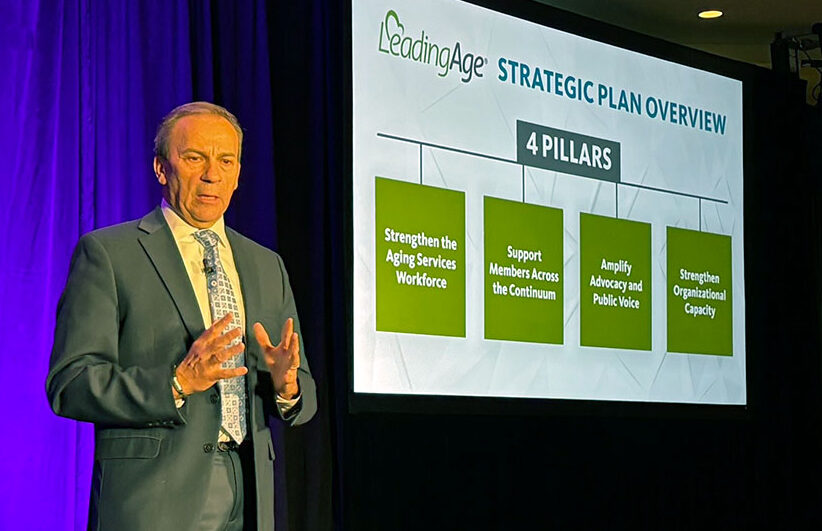LeadingAge Board Chair Roberto Muñiz, president and CEO of New Jersey-based Parker Health Group, presented LeadingAge’s new strategic plan for 2024-26 on April 16 at the 2024 LeadingAge Leadership Summit.
Describing the process behind the plan, “the result of extensive collaboration with members, staff, outside experts, and our leadership, Muñiz first explained the thinking behind LeadingAge’s restated vision: “An America that values older adults and those who serve them.”
“With this vision, LeadingAge says we value older adults and the gift of a long life, and we celebrate providers—like all of you, for the incredible work that you do every day,” he said. “Our purpose is noble; it is time for policy makers, the media, and the public to recognize aging as a stage of life and to understand through their actions that those who serve them deserve to be supported.”
Four Pillars to Thrive In the Future
“Without people to provide the care, there is no care,” said Muñiz, presenting the first of the four pillars upholding the strategic plan: Strengthen the Aging Services Workforce. Noting that “this is not just a nursing home issue,” he emphasized that the workforce focus covers the whole continuum of care and aging services professionals at all levels: “from service coordination in affordable housing to therapists in adult day centers, and more.”
For direct care professionals, he said, “we need to create career pathways that build skills and competencies that can support older adults—wherever they call home.” For leaders, he said, “LeadingAge has been deeply committed to building and enhancing the capacity of leaders in our membership. We know that at the end of the day, our future is secure when we grow leaders within our sector. This work will continue, including sharpening our focus on attracting and supporting leaders of color.”
Introducing the second pillar, Support Members Across the Continuum, Muñiz stated LeadingAge’s commitment to learn from, and co-create with, members as they develop new service models, new kinds of partnerships, and new ways of thinking about an aging society.
“We will be actively listening and engaging—and, together, shaping the future,” he said. “Shaping the future suggests change at the organizational level. We will continue to build our resources related to governance and look for new ways to reach teams of CEOs and board chairs. To effect change, we—as nonprofit organizations—need boards and strong leaders willing to take risks and make bold decisions.”
“Our purpose is noble; it is time for policy makers, the media, and the public to recognize aging as a stage of life and to understand through their actions that those who serve them deserve to be supported.”
Muñiz used the strategic plan’s third pillar, Amplify Advocacy and Public Voice, as a call to action for the Leadership Summit participants he was addressing. Members, he said, need “to be loud, to be proud, and to be convincing.” Because public policy drives so much of what we do, he added, “our approach has to be both offensive and defensive. Defensive to prevent bad ideas from seeing the light of day—and offensive to advance good ideas.” To the audience preparing to visit Capitol Hill on Lobby Day, he said, “Don’t hold back! Tell your stories. This is your chance to affect change.”
At the same time, he noted that advocacy must also include public awareness and putting our stories into the wider world: “We need to use our platform to raise public awareness of the importance of our issues to human lives, to ensure that the media sees us as a trusted source, and that policy makers are convinced by the power of our ideas and the truth of our stories.”
Muñiz completed his presentation with the fourth pillar, Strengthen Organizational Capacity, by committing to “stronger, even more impactful partnerships with our state affiliates. We are mutually dependent and as the world around us changes, we can do even more together—and we will.”

 Shutdown Week Three: Impact of Ongoing Closure on Affordable Housing
Shutdown Week Three: Impact of Ongoing Closure on Affordable Housing Colleagues on the Move, December 17, 2025
Colleagues on the Move, December 17, 2025


